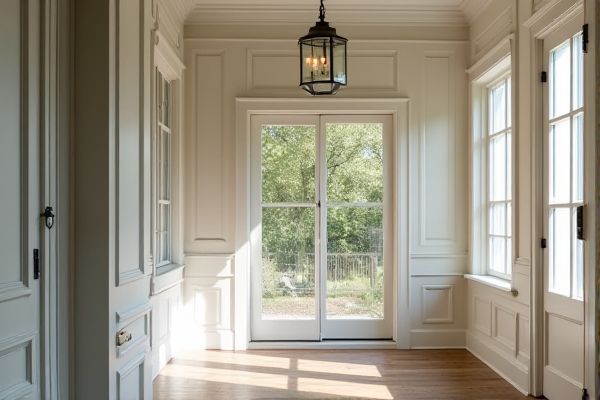
Open wainscoting on a porch features spaced vertical slats or panels that allow airflow and visibility, creating a more airy and inviting outdoor space. Closed wainscoting consists of solid panels that provide greater privacy and protection from the elements, making it a practical choice for your porch enclosure; explore the rest of the article to discover which option best suits your needs.
Table of Comparison
| Feature | Open Wainscot (Porch) | Closed Wainscot (Porch) |
|---|---|---|
| Structure | Exposed framing with open spaces | Enclosed with solid panels or siding |
| Ventilation | High airflow, natural ventilation | Limited airflow, less ventilation |
| Privacy | Minimal privacy, open view | Increased privacy with enclosed panels |
| Protection | Less protection against wind, debris | Better protection from elements and pests |
| Maintenance | Lower maintenance, easier inspection | Higher maintenance due to enclosed surfaces |
| Cost | Generally lower initial cost | Higher cost due to materials and labor |
| Aesthetic | Rustic, traditional look | Clean, finished appearance |
Introduction to Porch Wainscot: Open vs Closed
Porch wainscot enhances the durability and aesthetic appeal of exterior walls by protecting the lower portion from weather damage. Open wainscot features slats or lattice panels that allow airflow and drainage, ideal for ventilated porches, while closed wainscot uses solid panels for a more finished, enclosed look that adds privacy and insulation. You can choose between open and closed wainscot based on your porch's ventilation needs and desired architectural style.
Defining Open Wainscot for Porches
Open wainscot for porches features spaced vertical or horizontal boards that allow airflow and visibility while providing partial enclosure and decorative appeal. This design enhances ventilation, reduces wind impact, and maintains an airy, light-filled porch environment compared to closed wainscot, which uses solid panels for a fully enclosed look. Materials commonly used for open wainscot include treated wood, vinyl, or composite, chosen for durability and weather resistance.
Understanding Closed Wainscot for Porches
Closed wainscot for porches involves solid panels that provide complete enclosure between the porch floor and railing, enhancing privacy and protection from weather elements. This design contrasts with open wainscot, which features slats or lattice allowing air flow and visibility. Choosing closed wainscot improves insulation and security, making it ideal for creating a more sheltered and comfortable porch space.
Design Aesthetics: Visual Differences Between Open and Closed Wainscot
Open wainscot on porches features spaced slats or pickets that create a light, airy feel, allowing visibility and airflow while adding a decorative, traditional charm. Closed wainscot uses solid panels or boards, providing a more uniform, opaque surface that enhances privacy and offers a sleek, modern look. Your choice between open and closed wainscot shapes the porch's visual appeal, balancing openness with enclosure to match your aesthetic preferences.
Functional Benefits: Open Wainscot Porches
Open wainscot porches provide enhanced airflow and ventilation, reducing humidity and preventing mold buildup in outdoor spaces. The design allows natural light to penetrate more easily, improving visibility and creating a brighter porch environment. Open wainscot porches also offer better pest control by minimizing hidden areas where insects and rodents can nest.
Functional Benefits: Closed Wainscot Porches
Closed wainscot porches offer enhanced protection against wind, rain, and insects, creating a more comfortable and weather-resistant outdoor living space. By enclosing the lower portion of the porch, they provide additional privacy and security compared to open wainscot designs. This structural feature also helps retain heat, extending the usability of the porch during cooler seasons.
Weather Protection: Which Wainscot Option Performs Better?
Closed wainscot offers superior weather protection on porches by fully enclosing the lower wall area, preventing wind, rain, and debris from entering and reducing drafts. Open wainscot allows for air circulation and drainage but offers minimal defense against harsh weather conditions. For enhanced durability and moisture resistance, closed wainscot is the better performing choice in protecting porch structures against weather elements.
Ventilation and Airflow Considerations
Open wainscot porches feature slatted or spaced boards that promote natural ventilation, enhancing airflow and reducing moisture buildup beneath the porch floor. Closed wainscot porches use solid panels that limit air circulation, potentially leading to trapped humidity and increased risk of mold or wood rot. Proper ventilation design is crucial in closed wainscoting to maintain structural integrity and indoor air quality.
Cost Comparison: Open vs Closed Wainscot Installation
Open wainscot porches generally cost less to install than closed wainscot due to their simpler framing and less material usage, averaging 20-30% lower expenses. Closed wainscot requires additional sheathing, weatherproofing, and sometimes insulation, increasing labor and material costs significantly. Homeowners should factor in long-term maintenance and energy efficiency benefits when evaluating the upfront savings of an open wainscot.
Choosing the Right Wainscot Style for Your Porch
Choosing the right wainscot style for your porch depends on factors like climate, privacy needs, and aesthetic preferences. Open wainscot offers better air circulation and a more traditional, airy look, ideal for warm climates and casual outdoor spaces. Closed wainscot provides increased privacy and protection from the elements, making it suitable for cooler regions and creating a more enclosed, cozy porch environment.
 homyna.com
homyna.com